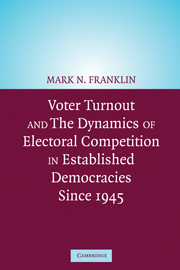Book contents
- Frontmatter
- Contents
- Figures
- Tables
- Preface
- The Authors
- Introduction
- 1 Confronting the Puzzles of Voter Turnout
- 2 A New Approach to the Calculus of Voting
- 3 The Role of Generational Replacement in Turnout Change
- 4 Rational Responses to Electoral Competition
- 5 Explaining Turnout Change in Twenty-Two Countries
- 6 The Character of Elections and the Individual Citizen
- 7 Understanding Turnout Decline
- 8 The Turnout Puzzles Revisited
- APPENDICES
- Bibliography
- Author Index
- Subject Index
4 - Rational Responses to Electoral Competition
Published online by Cambridge University Press: 08 February 2010
- Frontmatter
- Contents
- Figures
- Tables
- Preface
- The Authors
- Introduction
- 1 Confronting the Puzzles of Voter Turnout
- 2 A New Approach to the Calculus of Voting
- 3 The Role of Generational Replacement in Turnout Change
- 4 Rational Responses to Electoral Competition
- 5 Explaining Turnout Change in Twenty-Two Countries
- 6 The Character of Elections and the Individual Citizen
- 7 Understanding Turnout Decline
- 8 The Turnout Puzzles Revisited
- APPENDICES
- Bibliography
- Author Index
- Subject Index
Summary
In Chapter 2 we put forward a theoretical model that changes our approach to understanding voter turnout from one that focuses on why anyone would vote to one that focuses on why anyone would not vote. In Chapter 3 we established that one reason for not voting would be because of the failure to learn the habit of voting. In Chapter 3 we also established that there is a strong tendency for turnout variations to be led by the newest members of the electorates of each country, and especially by the entering cohort. Variables relating to the character of elections have much greater effects on individuals who have not yet become set in their ways – effects that can cause those individuals to vote at either a higher or a lower rate than their older counterparts. Indeed, we also see traces of the same effects acting on earlier cohorts: traces evident in the different levels that we see in the turnout of particular older cohorts. Though turnout in general has been declining in recent years, we saw clearly that the susceptibility of the youngest cohorts to the character of elections is not just a susceptibility to lower turnout; they can also be induced to vote at higher rates than preceding cohorts (most notably in Germany in 1998, in Sweden in 1994, and in The Netherlands in 1994 – see Table 3.2).
What are these forces that induce more people to vote in some elections than in others?
- Type
- Chapter
- Information
- Voter Turnout and the Dynamics of Electoral Competition in Established Democracies since 1945 , pp. 91 - 118Publisher: Cambridge University PressPrint publication year: 2004



